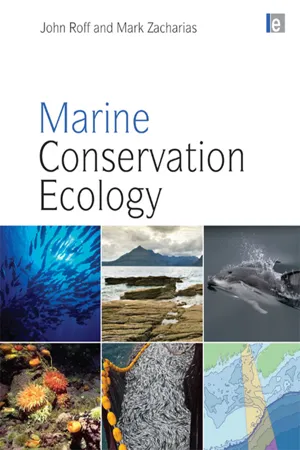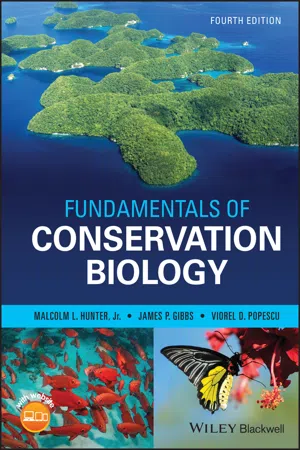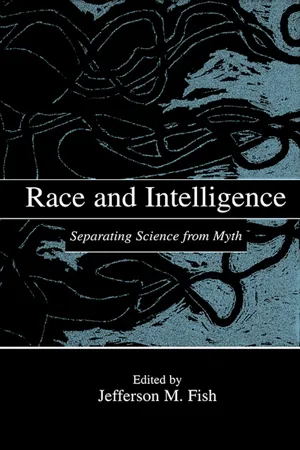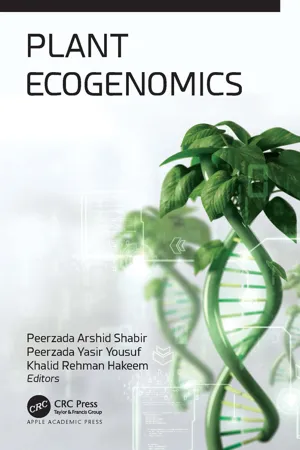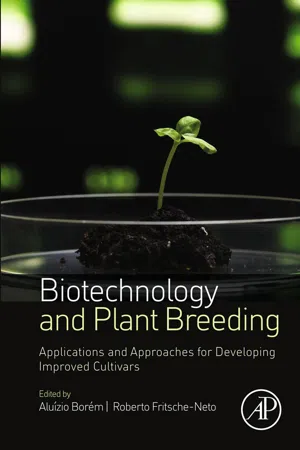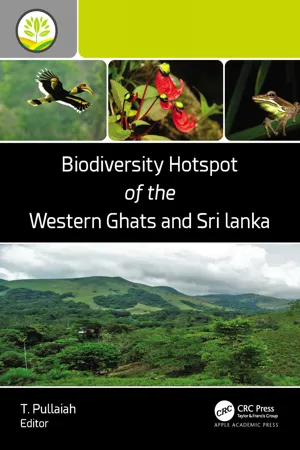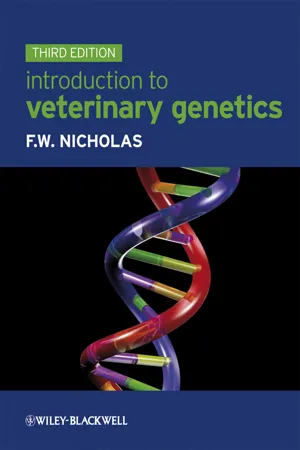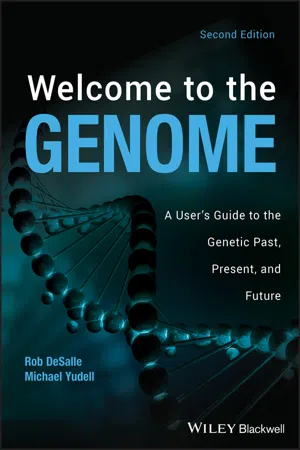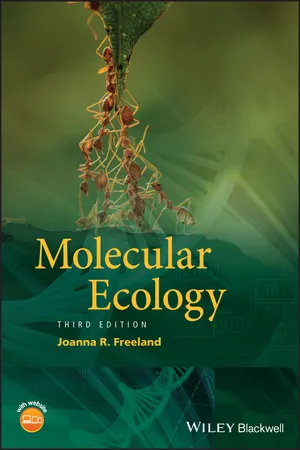Biological Sciences
Genetic Diversity
Genetic diversity refers to the variety of genetic information within a population or species. It encompasses the range of different alleles, genes, and genetic traits present in a group of organisms. Genetic diversity is important for the long-term survival and adaptability of a population, as it provides the raw material for evolution and allows species to respond to environmental changes.
Written by Perlego with AI-assistance
Related key terms
10 Key excerpts on "Genetic Diversity"
- eBook - ePub
- John Roff, John Roff(Authors)
- 2013(Publication Date)
- Routledge(Publisher)
Genetic Diversity is the level of biodiversity that describes the total number of genetic characteristics in the make-up of a species; it differs from genetic variability, which is the tendency of genetic characteristics to vary. Genetic Diversity can be considered in three components: within an individual (e.g. the proportion of polymorphic loci across the genome); within a subpopulation (i.e. the types and frequencies of alleles present, or mean individual heterozygosity within a population); and divergence among populations (i.e. the mean genetic difference among population locations). For any management purposes it is crucial to allocate these proportions of variation to determine how Genetic Diversity is spatially distributed, so that regions of conservation interest can be identified.Genetic Diversity plays a major role in the survival and adaptability of a species. When a species’ environment changes, slight genetic variations can result in changes in an organism's biology that enables it to adapt and survive. A species with a high degree of Genetic Diversity among its populations will have more variations from which the alleles that are most fitted to a habitat can be selected. A high level of Genetic Diversity is also essential for species to evolve. Species that have low genetic variation are at a greater risk of extinction. With low gene variation within a species, reproduction leads to inbreeding and its associated problems. For example, the vulnerability of a population to certain types of diseases can increase with reduction in Genetic Diversity. The modern causes for the loss of Genetic Diversity among organisms include selective breeding for agriculture and aquaculture, and habitat destruction leading to the loss of whole species and reduction in the numbers of separate species’ populations (meta-population erosion). Genetic Diversity and biodiversity as a whole are dependent upon each other; Genetic Diversity within a species is necessary to maintain diversity among species, and vice versa.Genetic ‘value’
At the genetic level itself the concept of ‘value’ has been applied to describe the genetic uniqueness of individual taxa. The best known example is perhaps that of the New Zealand lizard – the Tuatara (Sphenodon - eBook - ePub
- Malcolm L. Hunter, James P. Gibbs, Viorel D. Popescu(Authors)
- 2021(Publication Date)
- Wiley-Blackwell(Publisher)
Genetic Diversity is essentially a measure of the diversity of information a species has encoded in its genes. This information determines the form and function of every organism, and, when expressed as different species, genera, families and so on, underpins all biological diversity on the planet. One way of measuring it “qualitatively” is based on the distribution of different alleles among individuals and can be expressed as polymorphism (which is based on the proportion of genes that have more than one common allele) and heterozygosity (which is based on the proportion of genes for which an average individual is heterozygous). Another way to measure genetic variation is based on continuous or “quantitative” characters such as height, weight, seed set, etc. that are controlled by many genes as well as the environment. Genetic Diversity is important for three primary reasons: evolutionary potential, loss of fitness, and utilitarian values. Species with high levels of Genetic Diversity: (1) are better equipped to evolve in response to changing environments; (2) are less likely to suffer a loss of fitness because of the expression of deleterious recessive alleles in homozygous individuals, among other problems; and (3) offer plant and animal breeders greater scope for developing varieties with specific desirable traits such as resistance to certain diseases. Genetic Diversity is eroded by phenomena associated with small population size. First, when a population is reduced to a small size (i.e. it passes through a bottleneck), some genetic variance and uncommon alleles are likely to be lost. Similarly, in populations that remain small for multiple generations, random genetic drift changes the frequency of alleles; this often reduces Genetic Diversity, particularly when genes become fixed for a single allele. Finally, inbreeding between closely related individuals can diminish Genetic Diversity. In contrast, breeding between individuals from very different parts of a species’ range can generate offspring adapted to nowhere in particular, a problem called outbreeding depression. When estimating the effects of these processes on populations, it is important to estimate the effective population size, which is often substantially less than the actual population size. Conservation biologists should be concerned with cultural diversity, the information that many animal species, including humans, pass from generation to generation through learning. In summary, genetics plays a special role in conservation biology. Ever more discriminating technologies are continually evolving for assessing genetic variation, underpinning an expanding role for conservation genetics in informing conservation practice. - eBook - ePub
Race and Intelligence
Separating Science From Myth
- Jefferson M. Fish, Jefferson M. Fish(Authors)
- 2013(Publication Date)
- Routledge(Publisher)
T he life on our planet displays an amazing range of diversity at alllevels of biological organization: different kingdoms of life, several millions of species, and Genetic Diversity within species. Some of the Genetic Diversity within species is present simply as allelic differences (alternative forms of the same gene) carried by a single individual (heterozygosity), some occurs as genotypic differences among individuals living in the same local area, and some exists as allele frequency differences among different local populations. All of this Genetic Diversity is the product of the evolutionary process. Hence, to understand the significance of Genetic Diversity, it is necessary to place that diversity into its proper evolutionary context. Because evolution is a biological universal, the methods of analysis for interpreting Genetic Diversity are applicable to all species, including our own. Unfortunately, humans have tended to interpret their own intraspecific diversity in ways that are often inconsistent with how humans analyze and interpret Genetic Diversity in other species. As I show in this chapter, this is certainly the case concerning “racial” variation. From a scientific perspective, the interpretation ofhuman Genetic Diversity in a unique manner is indefensible: A scientific understanding and interpretation of human Genetic Diversity must use the same criteria that have been applied to Genetic Diversity in nonhuman species. My primarygoal in this chapter is to examine the significance of human Genetic Diversity, primarily racial diversity, using the same criteria and ana-lytical procedures applied to the remainder of life on this planet. This is not to say that humans are not a unique species—we certainly are—but it does acknowledge the fact that our Genetic Diversity is subject to the same basic types of evolutionary forces that shape diversity in all life.What is Genetic Diversity?All concepts of race are ultimately based on patterns of Genetic Diversity within and among the local breeding populations of a species. Therefore, the meaning of Genetic Diversity must be explored before addressing the concept of race. The basic units of Genetic Diversity are alleles, alternative forms of the same gene at a locus. Individuals generally carry two copies of each type of gene (one from the mother, and one from the father), so even an individual can display Genetic Diversity when the gene from the mother is of a different allelic type than the gene from the father. When this occurs, the individual is said to be heterozygous. If both copies of the gene are of the same allelic form, the individual is said to be homozygous - eBook - ePub
- Peerzada Arshid Shabir, Peerzada Yasir Yousuf, Khalid Rehman Hakeem, Peerzada Arshid Shabir, Peerzada Yasir Yousuf, Khalid Rehman Hakeem(Authors)
- 2022(Publication Date)
- Apple Academic Press(Publisher)
Diederichsen and Richards, 2003 ). This facilitates the conservation of trait-specific genotypes/accessions that can be used in crop improvement by following conventional and non-conventional approaches.Biodiversity is the repository that offers an opportunity to meet our food and nutritional requirements sustainable by maintaining natural genetic variation at intra- and interspecific levels in the biological systems. The main aim of conserving genetic variability is to improve the social and economic status of poor people to meet their food and nutritional requirements and at the same time keeping their cultural diversity intact. There is an unequal distribution of biological resources and thus the countries should collaborate for effective conservation and utilization at a global level (Rao and Hodgkin, 2002 ). Assessment of population structure and genetic variability in rare and endangered plant species is of vital importance for the development of conservation and management strategies because it provides valuable insights into the demography, reproduction, and ecology of species (Zaya et al., 2017 ).10.2 FACTORS RESPONSIBLE FOR Genetic Diversity
The extent of variation observed within and among the individuals/genotypes/accessions of a population or species is defined as Genetic Diversity (Brown, 1983 ). It depends on some important factors which include the presence of different forms of a gene (alleles) among individuals, their interaction, distribution, and the influence they have on performance and total variation presented by the individuals of a population/species. This total variation is determined by the frequency of mutation and recombination. Other factors include selection, genetic drift, and the amount of gene flow in different populations that cause the variation in the population (Brown, 1988 ; Hamrick et al., 1992 - eBook - ePub
Biotechnology and Plant Breeding
Applications and Approaches for Developing Improved Cultivars
- Aluízio Borém, Roberto Fritsche-Neto(Authors)
- 2014(Publication Date)
- Academic Press(Publisher)
Studies about Genetic Diversity have been of great importance for the purposes of genetic improvement and to evaluate the impact of human activity on biodiversity. They are equally important in the understanding of the microevolutionary and macroevolutionary mechanisms that act in the diversification of the species, involving population studies, as well as in the optimization of the conservation of Genetic Diversity. They are also fundamental in understanding how natural populations are structured in time and space and the effects of anthropogenic activities on this structure and, consequently, on their chances of survival and/or extinction. This information provides an aid in finding the genetic losses generated by the isolation of the populations and of the individuals, which will be reflected in future generations, allowing for the establishment of better strategies to increase and preserve species diversity and diversity within the species.Genetic resources are established by accesses that represent the genetic variability organized in a set of different materials called germplasm. They comprise the diversity of genetic material contained in old, obsolete, traditional, and modern varieties, wild relatives of the target species, wild species and primitive lines, which can be used in the present or in the future, for food, agriculture, and other purposes.The most important causes of loss of biodiversity and of genetic resources are: the destruction of habitats and natural communities; genetic vulnerability; genetic erosion; and genetic drift. The Genetic Diversity of the species is an important way to maintain the natural capacity to respond to climatic changes and all types of biotic and abiotic stress. In actuality, there exists great concern in evaluating biodiversity, because of the marked loss of Genetic Diversity, mostly due to the actions of man, replacing local varieties with modern varieties, hybrids, and, most recently, clones, so that large expanses of area are occupied by one or a few varieties or narrow genetic base. - T. Pullaiah, T. Pullaiah(Authors)
- 2024(Publication Date)
- Apple Academic Press(Publisher)
Chapter 10 Genetic Diversity Of Crop Plants Of The Western Ghats MAYA PERINGOTTILLAM and ALAGU MANICKAVELU Department of Genomic Science, Central University of Kerala, Kasaragod, Kerala, IndiaAbstract
Genetic Diversity is the unlikeness in genetic constitution among individuals of a population, a species, or a community. It is an evolutionary adaptation that confers the very existence of organisms on the earth. Nevertheless, humans utilize this Genetic Diversity to create desirable changes in the characteristics of convenient organisms. Therefore, understanding crop Genetic Diversity is a prerequisite for improving the beneficial attributes of crop plants and fostering awareness of different ecologically significant concepts such as genetic drift, inbreeding, mutation, population fitness, extinction, stability of ecosystems, etc. The Western Ghats is an exceptionally diverse ecosystem in peninsular India, containing a large portion of the country’s flora and fauna. This chapter focuses primarily on reporting the Genetic Diversity assessments conducted so far among crop plants across the Western Ghats. The chapter covers current trends and gaps in crop diversity assessments and suggests the most appropriate means for detecting high genetic differentiation.10.1 Introduction
Genetic Diversity is a broad term that encompasses all variations occurring within a single species or between different species in respect of their total genetic composition. It is the foundation of biodiversity that contributes to the survival of individuals and species under dynamic circumstances. The Western Ghats, the exceptionally diverse ecological region covering an area of 129,037 km2 , runs parallel to the west coast of peninsular India, traversing Tamil Nadu, Kerala, Karnataka, Goa, Maharashtra, and Gujarat. Although the Western Ghats constitute only 6% of India’s total area, it contains more than 30% of significant flora and fauna (Molur et al., 2011 ), which is enough to showcase its enormous heterogeneity. Moreover, the Western Ghats agroecosystem harbors high levels of endemism and is considered as one of the 36 biodiversity hotspots of the world (Ramachandra and Suja, 2006 ). Recently, Pradheep et al. (2021 ) have compiled the latest checklist of 306 angiospermic taxa cultivated in Kerala, highlighting the depth of Genetic Diversity in the Western Ghats region. The crop diversity of the Western Ghats is composed of diverse crop plants such as rice, sorghum, finger millet, small millet, black gram, green gram, cowpea, pigeon pea, Dolichos bean, horse gram, sword bean, okra, eggplant, cucumber, chilli/capsicum sp, taros, yams, elephant foot yam, jackfruit, banana, lemon, orange, Syzygium sp, sugarcane, black pepper, turmeric, ginger, coconut, areca nut, cotton, tea, coffee, rubber, and their wild relatives (Sivaraj et al., 2013 ). The propagation of selected excellent varieties of crop plants and ceaseless anthropogenic activities in these areas led to the depletion of wild genetic resources (Lathankumar et al., 2016- eBook - ePub
- Frank W. Nicholas(Author)
- 2013(Publication Date)
- Wiley-Blackwell(Publisher)
ex-situ conservation by storage of gametes or zygotes. However, this form of technology is available for only a very limited range of species. As also with domesticated species, cloning from differentiated cells offers a longer-term prospect.Summary- If a population can be genotyped for some DNA markers, its level of Genetic Diversity can be estimated as observed heterozygosity, expected heterozygosity, allelic diversity, and effective number of alleles
- The genetic distance between two populations is the extent to which their allelic frequencies differ
- The Genetic Diversity between two populations can also be estimated by counting the number of bases at which the sequence of a particular locus differs between the two populations
- Each of the above measures of Genetic Diversity among populations is typically estimated for all pairwise combinations of a set of populations (breeds or isolated populations or species), from which it is possible to construct a phylogenetic tree, showing the relationship of each population to every other population
- Genetic Diversity is important because it is the only means by which populations can immediately respond to selection (artificial and/or natural) either now or when circumstances change in the future
- The biggest threat to Genetic Diversity in livestock species in recent times has been selection between breeds
- For non-domesticated species, the main threat to Genetic Diversity is human encroachment
- To maintain around 90 per cent of a population’s Genetic Diversity for 100 years, the effective population size must be around 500/L ; and to retain evolutionary potential in the longer term (where generation intervals are not relevant), an effective population size of at least 500 is required
- Captive breeding programmes conducted by zoos and other organizations are good examples of the practical application of population and quantitative genetics
Further readingBoakes, E.H., Wang, J. and Amos, W. (2007) An investigation of inbreeding depression and purging in captive pedigreed populations. Heredity , 98 - eBook - ePub
Welcome to the Genome
A User's Guide to the Genetic Past, Present, and Future
- Robert DeSalle, Michael Yudell(Authors)
- 2020(Publication Date)
- Wiley-Blackwell(Publisher)
5 )Figure 7.1If you look closely at the two sequences of DNA above, from identical regions of human chromosome 1, there is a single base pair difference. This difference, known as a single nucleotide polymorphism (SNP), occurs approximately every 1000 bases in the human genome.Credit: Rob DeSalle, American Museum of Natural HistoryGenomic variation between people accounts for the diversity of physical traits that we see today among all the world’s many peoples. It is these variations, visible to the naked eye, that have been used for centuries to place human populations into racial groups. Scientists now understand, however, that these physical traits are not a biologically sound way in which to divide Homo sapiens. We now know, for example, that sub‐Saharan Africans have more “genetic variability than all other human populations combined.” (6 ) We also know from looking around us that so‐called racial groups actually contain a tremendous amount of physical diversity and that no group is defined by a set of fixed characteristics. From everyday experience, we can see that no single member of a group typifies all the members of that group.Thinking about human Genetic Diversity in the context of a family shows that related individuals share more of their DNA with one another. On average, parents and their biological child will have 1.5 million base pair differences in their DNA. Each parent gives the child half of his or her genome, a half practically identical to that of the parent. A child therefore has almost zero differences between his or her mother and her half of their genome and almost zero differences between his or her father and his half of their genome. Either half of a child’s genome, therefore, has approximately 1.5 million differences from the opposite parent. - eBook - ePub
- J.N. Spuhler(Author)
- 2017(Publication Date)
- Routledge(Publisher)
Individuals of which a species is composed may be regarded as more or less faithful or defective incarnations of the species archetype. This is the typological approach. In modern biology it usually takes a disguise. For example, it is postulated that there exists somewhere, or can be obtained by breeding, the optimal genotype (= archetype), composed entirely of genes adaptively most favorable in a given environment, or even in all environments in which the species can live. Individuals observed in reality deviate more or less noticeably from the postulated possessors of the optimal genotype; they carry “genetic loads,” which, in theory, can be measured by their deviations from the optimum genotype. The populational approach envisages a biological species as a Mendelian population composed of carriers of diverse genotypes. No genotype can really be “optimal,” because the population faces a great variety of environments, inconstant in space , and in time and with different adaptive requirements. How great is the Genetic Diversity within a given species is at best only sketchily known. In particular, the Genetic Diversity in the human species is explored quite inadequately. The matter needs more investigation, research, and analysis. This is one of the pivotal problems in the present book, and what I am trying to do in this introductory discussion is to place it in its proper perspective.According to Ford’s (1940) original definition, an interbreeding population is said to be genetically polymorphic if it consists of two or more clearly distinct and genetically different kinds of individuals. Some species and populations are obviously highly polymorphic, others less so, and still others seem to be monomorphic. The matter is, however, beset with complications. Our ability to recognize polymorphisms depends upon the techniques used. Before 1900 there was little reason to suppose that human populations are polymorphic for blood groups, because techniques were not available for diagnosing them. New biochemicalpolymorphisms are now being discovered in man almost annually, and the end is not yet in sight.The immense field of polygenic variability is explicitly excluded by Ford’s definition of polymorphisms, because polygenes, also by definition, do not produce discontinuous and phenotypically discrete variants. Yet at the biochemical level there is presumably no difference between the major genes and the polygenes. Some geneticists are loath to venture from the solid ground of discrete gene effects to the apparent morass of polygenes. The classical methods of genetics, recording the Mendelian segregation ratios in the progenies of hybrids, are not easily applicable to polygenic inheritance. (See, however, the paper by Thoday in the present volume.) Biometrical methods, selection experiments, and heritability determinations have to be used. Some geneticists have even recommended that a kind of moratorium be declared on studies of polygenic inheritance, until such time as it can be reduced to molecular terms and then presumably handled by the classical methods. I do not think this recommendation stands a chance of being adopted, for the simple reason that a majority of the differences between normal, nonpathological humans happen to be manifestations of polygenic differences. This field of study is too important to be relegated to an indefinite future time. Most relevant to our discussion, the nonpathological genetic variations in behavior traits in man seem to be mostly under polygenic control. - eBook - ePub
- Joanna R. Freeland(Author)
- 2019(Publication Date)
- Wiley(Publisher)
2015 ).What Influences Genetic Diversity?
Genetic Diversity is influenced by a multitude of factors, and therefore varies considerably between populations. In the remaining sections of this chapter we shall look at some of the most important determinants of Genetic Diversity, which include genetic drift, natural selection, reproduction, and ecology. While reading about these, it is important to keep in mind that no process acts in isolation, for example the rate at which a population recovers from a bottleneck will depend in part on its reproductive ecology. Furthermore, it is difficult to predict the extent to which a particular factor will influence Genetic Diversity, because no two populations are the same. Nevertheless, several factors have a universal relevance to Genetic Diversity, and these will comprise the remainder of this chapter.Genetic Drift
Genetic drift is a process that causes a population's allele frequencies to change from one generation to the next simply as a result of chance. This happens because reproductive success within a population is variable, with some individuals producing more offspring than others. Some of this variation is a result of chance events such as flowering plants that are killed by trampling animals, i.e. they were in the wrong place at the wrong time and were not killed as a result of suboptimal evolutionary adaptation. These types of random events mean that not all alleles will be passed on to the next generation, and allele frequencies will therefore fluctuate from one generation to the next. Because genetic drift alters allele frequencies in a purely random manner, it results in non‐adaptive evolutionary change. The effects of drift are most profound in small populations, in which even small variations in reproductive success can rapidly lead to the loss of alleles from the population. Because genetic drift eventually leads to the fixation of one allele at a particular locus within a population (in other words the only remaining allele becomes fixed at a frequency of 1.0), its overall effect is to decrease the Genetic Diversity of small populations. Genetic drift also impacts relatively large populations but, as we shall see later in this chapter, a correspondingly longer time period is required before the effects become pronounced. Genetic drift is an extremely influential force in population genetics, and forms a basis for one of the most important theoretical measures of a population's genetic structure: effective population size (Ne ). Because genetic drift and Ne are closely linked, we will now spend some time looking at how Ne differs from census population size (Nc
Index pages curate the most relevant extracts from our library of academic textbooks. They’ve been created using an in-house natural language model (NLM), each adding context and meaning to key research topics.
